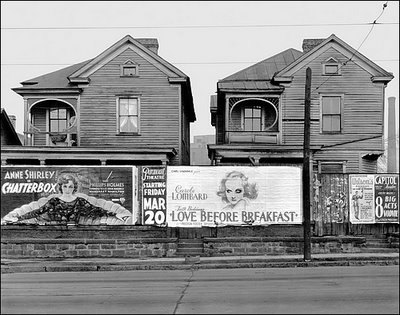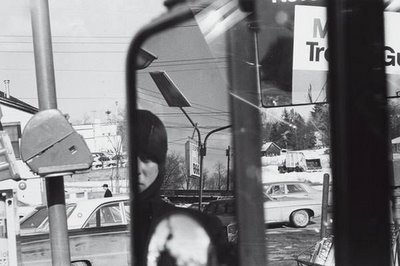'American Beauty'
I was at the National Gallery of Victoria the other weekend and stumbled across 'American Beauty: Photographs of the American Social Landscape 1930s-1970s, which is a nice demonstration of how much photography can say about the social world in a small space. It was also a welcome reminder of how much I love the medium.
Despite the grand title, it's a very safe little show, not one to light the curatorial world a'fire, and it's hung in that hideous little nothing space at the top of the escalator. Still, the show is a nice demonstration of how loaded the act of selection can be, both as a curatorial device and as a legitimation of photography as a fine art.
Stepping sideways down the selection of images can be a full lurch into another way of seeing and thus of life, from hot to cool, from the subjective to the apparently objective, though in the case of photography, objectivity is merely an appearance of distance and subjectivity merely a collection of aesthetic strategies. Which is why, I suppose, it was the medium of choice for postmodernists, but I digress.
I started with Walker Evans, a stately figure. An aesthetic Protestant if ever there was one. His pictures have the rigor of a Shaker chair. The prints are not his own but they are crisp and bright. My favourite is the astonishing 'Billboards and Frame Houses, Atlanta' (1936). Devastating in its matter-of-fact contrasts, it manages to say a great deal about the Great Depression, both its economic reality and its state of mind. Media vs real life, the hope of glamour and the reality of poverty. The houses look elegant until you notice the missing boards and the grime. Carole Lombard the seductive movie star sports a black eye, like a play-acted version of what might be going on in the houses behind. It's a political image, but one that avoids propaganda, and all the more powerful for that.
By contrast, Lee Friedlander is cool and dryly funny. Far more subjective, and hip where Evans is earnest. Urban life broken into fragments, experienced in parcels of space and time, suggesting the states of mind of the people who inhabit this world. People face into void spaces, into walls, or breaks in the continuity of the picture plane. Under 'Hillcrest, New York' (1970) is a quote from Friedlander in 1996 which made me smile. It summarizes his irony and humour, an irony without distance:
I only wanted Uncle Vern standing by his new car (a Hudson) on a clear day. I got him and the car. I also got a bit of Aunt Mary's laundry and Bean Jack the dog peeing on a fence, and a row of potted tuberous begonias on the porch and 78 trees and a million pebbles in the driveway and more. It's a generous medium, photography.
The show also features some of Robert Frank's groundbreaking work from the 50s, and pictures I don't think I've seen before from Jose Lopez and Luis Medina. They are a welcome shot of colour and heat. America the grotesque, the outsize, all-you-can-eat America, primary coloured and perverse. Where Friedlander implicates himself in the reality he presents, these photographers are distant appraisers of a foreign culture. The picture's frame standing in for the car window.


.jpg)





3 comments:
Thanks for the "American Beauty: Photographs of the American Social Landscape 1930s-1970s" link! Great stuff.
I was glad to see Robert Frank's name come up at the end.
The Paul-Bunyan-like figure in the final photo might already be familiar to people -- one appears in the opening credits for The Sopranos. According to the HBO site, thousands of these figures were made in the 60s and 70s. You can see the one from The Sopranos by clicking on #11 on this page:
http://www.hbo.com/sopranos/credits/index.shtml
Yes Michael, I remember one featuring in "Fargo", the Coen Brothers' movie. I think it stands at the entrance of the town of Brainerd, Minnesota.
Post a Comment